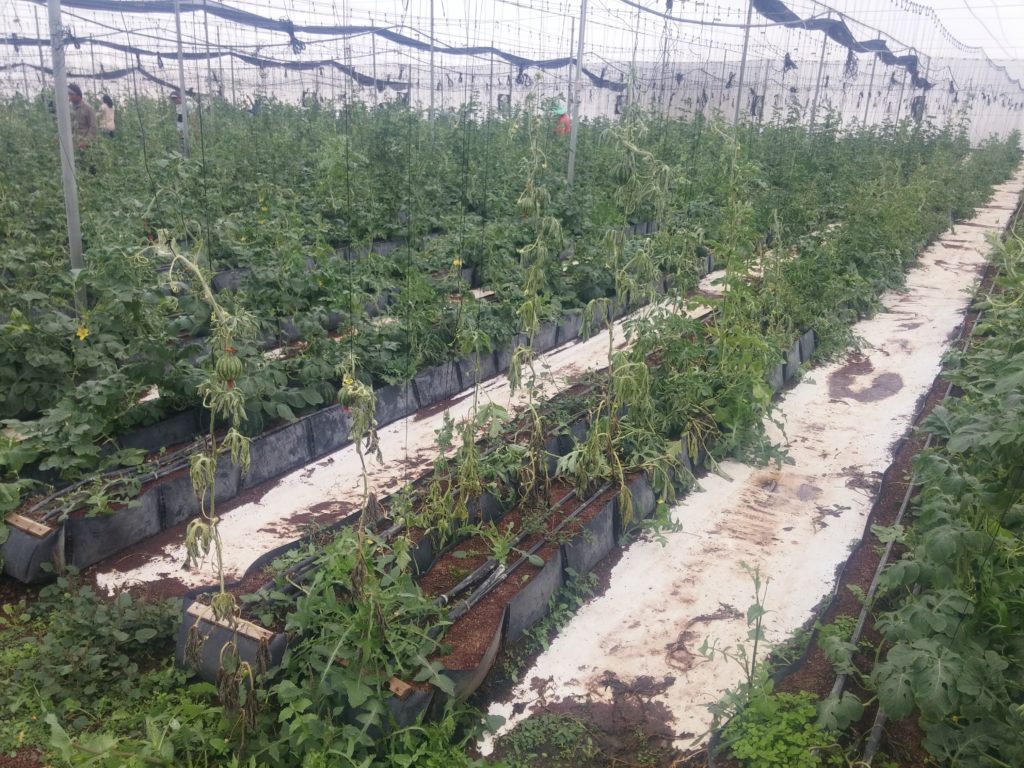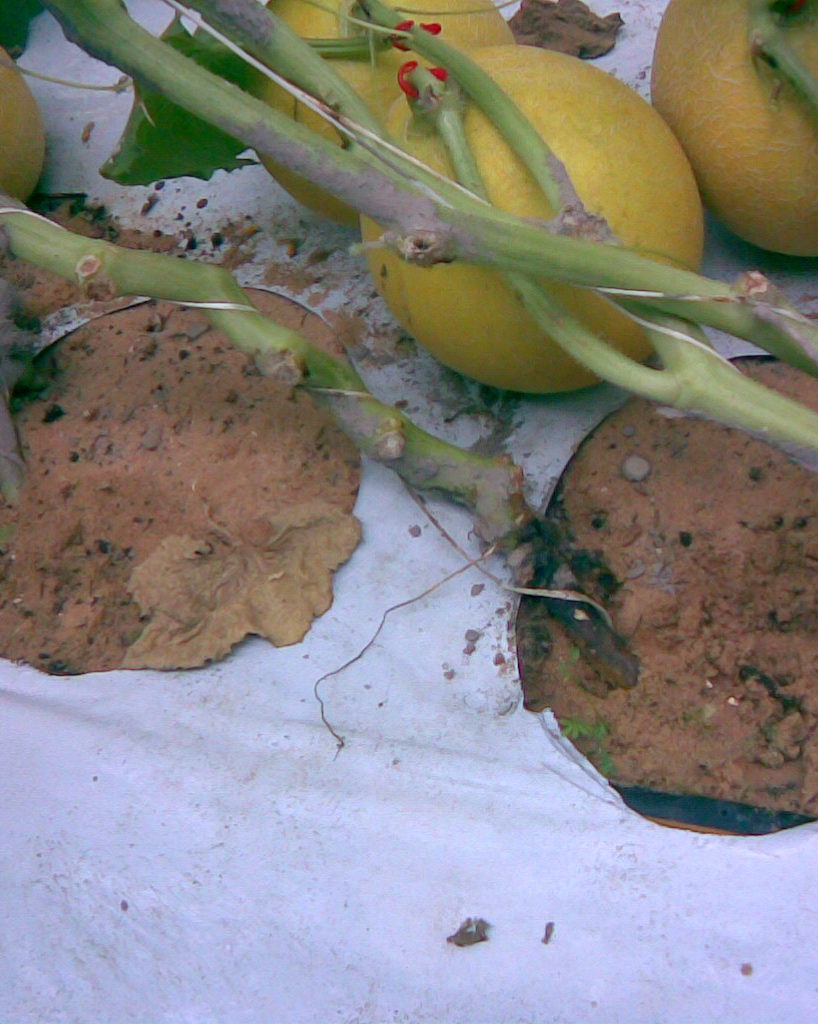The fusarium fungus harms the root, and the water & minerals transport tissues (xylem and flume), in the plants.
Expressed in the wilting of the leaves, root rot and a significant reduction in yield.
The fungus harms many species, including banana, lettuce, potato, tomato, melon, watermelon and cucumber.
The fungus spores can survive in the soil, sometimes for more than a year; it can also survive on other things such as pots, benches, irrigation equipment and pipework, tanks of nutrient solution and plant debris.
It can live at great depth (100 to 150 cm).
The spores which are drought-resistant can be spread in the air and in dust.
Insects and mites can also spread spores.
Spores are produced in massive numbers and can also be spread during handling of the plants or by watering.
It settles in the tip tubes and leads to clogging.
The incubation period is from 2 to 13 weeks.


The infected plant suffers from a significant shortage of water and nutrients leading to the appearance of symptoms of wilting.
The plant appears thirsty and as the disease progresses the leaves lighten and wither and later death of the plant.
Young plants may show no immediate symptoms even though infected.
The stem of the plant dries out and becomes hollow.
A cut in the stem will reveal the core is dry but white.
The chocolate brown lesion girdles the main stem just above the soil line.
Reddish to brown discoloration of the stem cortex when sliced lengthwise.
In many cases it will be possible to see signs of recovery at night, when there is a drop in the temperatures but as the disease progresses the whole plant will show signs of wilting without recovery.




A proper soil disinfection in this case, will reduce or kill all the fungus spores.
However, it will not prevent other fusarium spores from coming from other places due to their ability to be airborne.
Without soil disinfection there will be enormous quantities of fusarium spores in the ground which will contaminate immediately all the new seedlings of the new season.
After 2 months all the plants in the plot will be infected and wilt.
Soil disinfection will only postpone the infection of the plants, due to the reason that these spores will arrive with the air/dust/insects, and contaminate the roots.
Wilting plants will appear after 3 months, when the first harvest starts.
So, the two ways to deal with it, is using plants that have fusarium resistance or using a rootstock that have a resistance to fusarium.
But there is a third way:
Chemical:
PROCHLORAZ is a fungicide that can protect the roots from fusarium, by applying it through the irrigation system (as you apply liquid fertilizer) during the first month.
FLUDIOXONIL is also a fungicide that protects the roots from fusarium, by applying it through the irrigation system (as you apply liquid fertilizer) during the first month.
This method has almost 100% success.
The fungicide is best applied through the drip irrigation system (soil drench), 3 times.
1. one week after planting 2. Three weeks after planting 3. five weeks after planting.
You can choose to use PROCHLORAZ or FLUDIOXONIL , but not both of them together.
The amount is 0.15cc of PROCHLORAZ per plant for each time, so each plant gets around 0.45cc per season.
The amount of FLUDIOXONIL is 0.05cc per plant each time, so each plant gets 0.15 cc per season.

Organic:
Sodium hypochlorite:
This kind of soil disinfection, which is done only prior to planting is good mainly for hydroponic media, raised beds and pots, growing outside and indoors. It is also good for disinfecting soil.
Sodium hypochlorite is in fact household bleach.
The main ingredient is chlorine, which eliminates mold, fungus, bacteria and viruses.
Chlorine needs to be in full contact with its target, in order to get efficient disinfection, so you need to rinse the media until it is soaked, and then leave it for a few hours, or a day, or possibly more.
The chlorine evaporates, or you can wash it out with clean water.
The growing media which is not soil is disinfected better, because there is less organic substance inside.
The concentration of the chlorine in the sodium hypochlorite solution should be at least 1% (equivalent to 10000 ppm).
Regular household bleach has a concentration of 5%, so you need to mix 1 gal of bleach with 2 gal of water.
Bleach tablets for disinfection can be used also.
Simply dissolve the tablets in water as instructed (2 tablets in 1 gallon gives 1%), and you have the solution ready to use.
If your planting media is too large to wash, like regular soil, you can wash only the planting pit, each with 5-7 oz, using the solution.
By this, you disinfect only the initial planting media that the seedling encounters, and can avoid diseases attacking young seedlings, like pythium.


Trichoderma
For prevention use only.
It’s a genus of adaptable fast-growing soil fungi, that form symbiotic relationships with plant roots.
It forms a physical bond with the root system of the plants, establishing itself in the root zone and thereby preventing other pathogens from colonizing the soil.
This forms a physical barrier to plant pathogens, and eliminates fungal pathogens by colonizing the root systems of plants.
It has proven to be useful in controlling common soil-borne diseases like Fusarium, Pythium and Rhizoctonia on a wide range of crops.
How to apply:
Right after you sanitized or prepared your planting media (compost, bark, coir, or peat, rock wool, hydroton, etc.), disperse and mix the agent lightly in the planting media.
You can also do it at the time of planting, in the planting pit, but better before planting.
It can be applied in seed trays, preventing pythium (damping off).
One application provides up to three months of control.
You might also like these articles:
- Slow-Release Fertilizers for Trees and Shrubs
- A Plant’s Nutritional Needs: The Best Fertilizer for Each Stage of Plant Growth
- How to Use Roundup Effectively and Safely
- Weed Control in Your Garden: Choosing and Using Herbicides Safely and Effectively
- Effective Herbicides for Common Weeds in Lawns and Gardens
- Starting Seedlings from Seeds: Read This First
- Unleash the Magic of Mulch: Transform Your Garden Today!
- Transform Your Soil into a Vibrant Garden Oasis with the Power of Soil Amendments
- 10 high rated tillers for small/medium yard reviews
- Top-Ranked small to medium-sized yard Lawn Mowers review
- Tips for Growing an Avocado Tree: Climate Factors, Soil Needs, Tree Varieties, and Planting Methods
- Exploring the Benefits of Annual Flowers: Adding Color, Variety, and Easy Care to Your Garden












